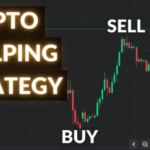Forex trading is an exciting and dynamic financial market where traders can capitalize on the fluctuations in currency exchange rates. It requires dedication, skill, and effective strategies to navigate this highly competitive arena. In this article, we will explore the top 10 forex trading strategies that can help you maximize your profits and minimize risks.
Scalping is a popular forex trading strategy that involves making short, quick trades to profit from small price movements. Traders using this strategy open and close positions within minutes or even seconds. This strategy requires a high level of focus, discipline, and technical analysis skills.
2. Swing Trading Strategy
Swing trading involves identifying and taking advantage of price swings or short-term trends. Traders using this strategy hold positions for days or weeks, aiming to capture larger price moves. This strategy requires a combination of technical analysis, chart patterns, and market sentiment analysis.
3. Trend Following Strategy
Trend following is a strategy that aims to identify and capitalize on the sustained movements in the market. Traders using this strategy analyze charts and indicators to identify and follow the prevailing trend. This strategy requires patience, discipline, and an understanding of market trends.
4. Breakout Strategy
The breakout strategy involves identifying key levels of support and resistance and entering trades when the price breaks out of these levels. Traders using this strategy aim to profit from strong, sudden price moves. This strategy requires proper risk management and the ability to identify breakout patterns.
5. Carry Trade Strategy
Carry trade is a strategy that takes advantage of interest rate differentials between currencies. Traders using this strategy borrow currencies with low interest rates to invest in currencies with higher interest rates. This strategy requires an understanding of central bank policies and interest rate dynamics.
6. Range Trading Strategy
Range trading involves identifying and trading within a defined range of prices. Traders using this strategy aim to buy at support levels and sell at resistance levels. This strategy requires technical analysis skills and the ability to identify ranges and price reversals.
7. Fundamental Analysis Strategy
Fundamental analysis involves analyzing economic, political, and social factors that can influence currency exchange rates. Traders using this strategy evaluate economic indicators, news events, and central bank decisions to make trading decisions. This strategy requires a deep understanding of fundamental factors and their impact on the forex market.
8. Carry Grid Strategy
The carry grid strategy involves opening multiple positions in the same currency pair, taking advantage of both positive and negative interest rate differentials. Traders using this strategy aim to generate income from the interest rate differentials and potential currency appreciation. This strategy requires careful risk management and monitoring of interest rate changes.
9. Price Action Strategy
Price action refers to the analysis of candlestick patterns, chart patterns, and price movements without the use of indicators. Traders using this strategy rely on the visual representation of price to make trading decisions. This strategy requires a keen eye for patterns and an understanding of market psychology.
10. News Trading Strategy
News trading involves taking advantage of price volatility around major news events. Traders using this strategy analyze economic calendars and enter trades based on the anticipated impact of news releases. This strategy requires quick thinking, fast execution, and an understanding of market reactions to news.
Comparison Table
| Strategy | Definitive Features | Alternatives |
|---|---|---|
| Scalping Strategy | Quick trades, small price movements | Day trading, swing trading |
| Swing Trading Strategy | Short-term trends, larger price moves | Position trading, trend following |
| Trend Following Strategy | Sustained market trends | Breakout strategy, range trading |
| Breakout Strategy | Strong price movements | Range trading, trend following |
| Carry Trade Strategy | Interest rate differentials | Carry grid strategy, fundamental analysis |
| Range Trading Strategy | Buying at support, selling at resistance | Breakout strategy, swing trading |
| Fundamental Analysis Strategy | Economic factors, central bank decisions | News trading, price action strategy |
| Carry Grid Strategy | Multiple positions, interest rate differentials | Carry trade strategy, breakout strategy |
| Price Action Strategy | Candlestick patterns, chart patterns | News trading, swing trading |
| News Trading Strategy | Price volatility, economic events | Carry trade strategy, range trading |
FAQs
- Which forex trading strategy is the best?
There is no one-size-fits-all answer to this question. The best strategy for you depends on your trading style, risk tolerance, and market conditions. It’s important to experiment with different strategies and find the one that suits you best.
- How do I choose the right strategy?
To choose the right strategy, consider factors such as your trading goals, time commitment, and level of expertise. Research different strategies, practice using demo accounts, and seek guidance from experienced traders or mentors.
- Can I combine multiple strategies?
Yes, it is possible to combine multiple strategies to create a personalized trading approach. However, it’s important to ensure that the strategies are compatible and complement each other to avoid confusion and conflicting signals.
- How long does it take to become proficient in a strategy?
The time it takes to become proficient in a strategy varies from trader to trader. It depends on your dedication, practice, and ability to adapt. Generally, it takes months or even years of consistent practice to become proficient in a strategy.
Conclusion
Having an effective forex trading strategy is crucial for success in the highly volatile forex market. The top 10 strategies discussed in this article provide a foundation for traders to choose from. Remember, no strategy guarantees profits, and it’s important to adapt and refine your approach based on changing market conditions and personal experience.







